The Samsung Galaxy Note5 and Galaxy S6 edge+ Review
by Joshua Ho on October 2, 2015 8:00 AM ESTBattery Life
Battery life is undoubtedly one of the most important parts of the user experience of any mobile device. One of the major reasons why many people use phablets is to get better battery life, as the PCB size of a phablet is often roughly similar to what you’ll see in a smartphone, but the battery will be bigger to fill the available space. As a result, a phablet has a higher proportion of battery than a smartphone. This inherently means that battery size will scale faster than platform power. In order to test this metric, we use a number of different tests ranging from display-bound web browsing to SoC-bound CPU and GPU load tests. In order to eliminate confounding variables, we test all devices from the same ASUS RT-AC68U router for WiFi testing, and in strong LTE/3G reception for mobile web browsing, in addition to setting all devices to an average of 200 nits on the display.
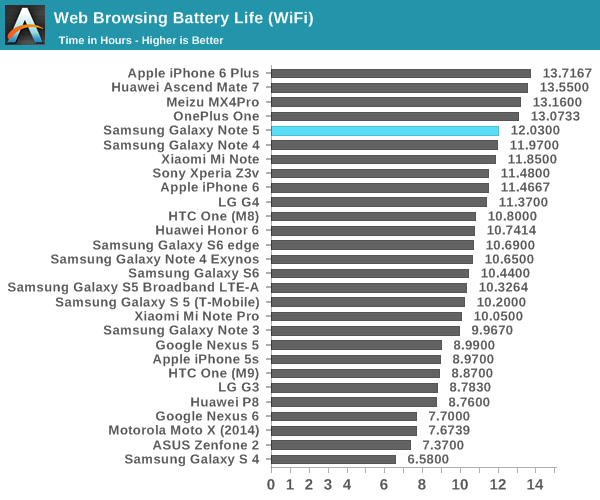
In our first test of WiFi web browsing, the Galaxy Note5 performs identically to the Galaxy Note 4. This might be surprising because the display is the same size and resolution as the Galaxy Note 4 with a smaller battery than the Galaxy Note 4. However, the smaller battery is compensated for due to improvements in SoC and display efficiency. In particular, the move from a planar 28nm process to a 14nm FinFET process dramatically reduces power consumption on the SoC.

In LTE battery life, we see a noticeable drop relative to WiFi battery life. It’s likely that this is mostly due to the power consumption of the Shannon 333 modem present in these devices. There’s not much else to say here, but battery life is still good.
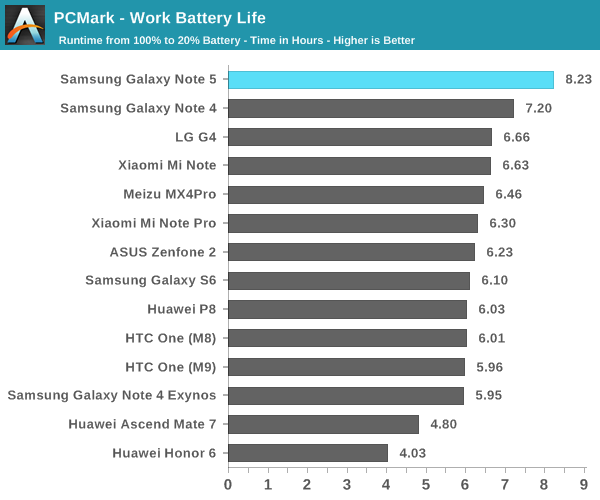
Moving past our mostly display-bound web browsing test, PCMark provides a much more balanced look at battery life as APL tends to vary a bit more with content like videos and photos instead of just webpages, and the CPU component is much more strongly emphasized. Here we can really see the Note5’s Exynos 7420 stretch its legs as it keeps a high performance level with long runtime.
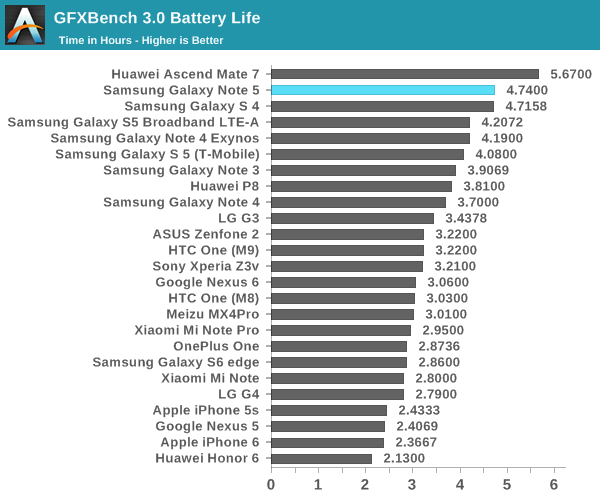
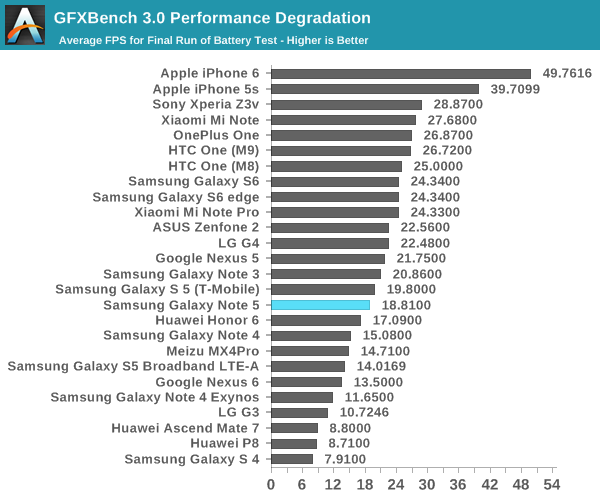
In our sustained SoC-bound workloads, GFXBench shows a healthy improvement over the Galaxy S6. Although we’re unable to test in perfectly controlled temperatures, it looks like Samsung has improved the throttling behavior of the SoC as the throttling appears to be more graceful rather than sinusoidal, and the result is a pretty significant jump in runtime over most devices.
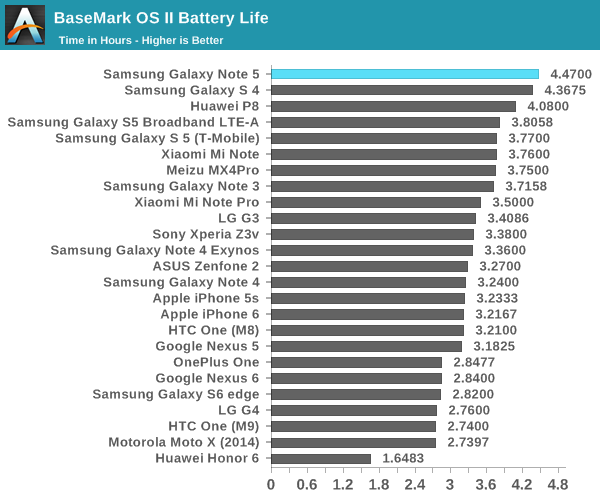

In Basemark OS II, we see a pretty significant uplift in runtime when compared to something like the Galaxy S6 or Note 4. The runtime increase isn’t just due to excessive throttling though, as the battery score shows that this isn’t just a case of throttling the CPU until the runtime is an improvement over past devices.
Overall, if you’ve read the Galaxy S6 review it’s pretty fair to say that you’ll know what to expect from the Galaxy Note5. Battery life is roughly equivalent to the Galaxy Note 4 despite the smaller battery, and due to the greatly improved Exynos 7420 SoC relative to 2014 SoCs SoC-bound cases will show pretty healthy improvements as long as you’re controlling for performance.
Charge Time
While normally battery life is the primary area of concern for a smartphone, in some cases it’s important for a phone to charge quickly. We can all claim to be perfect but one of the simplest cases for faster charging is forgetting to plug the phone in before going to sleep, so the maximum allowable charge time goes from something like 6 hours to an hour at best. As a result, a faster charger can dramatically improve practical battery life in any situation where you have limited time to charge. This can be accomplished by increasing either the current or voltage of the charger. The original quick charging standards improved charge rate through higher current, but this eventually hits a wall due to resistance in the wire. In order to increase the total amount of power delivered without increasing the thickness of the cable used voltage was increased in the case of newer standards like QC 2.0. In the case of the Galaxy Note5 and Galaxy S6 edge+, we’re looking at the same 9V, 1.67A QC 2.0 compatible charger that shipped with the Galaxy Note 4. In order to test this properly, we log the time it takes for the phone to charge by running a timer until the charger power draw hits a point that represents 100% battery.
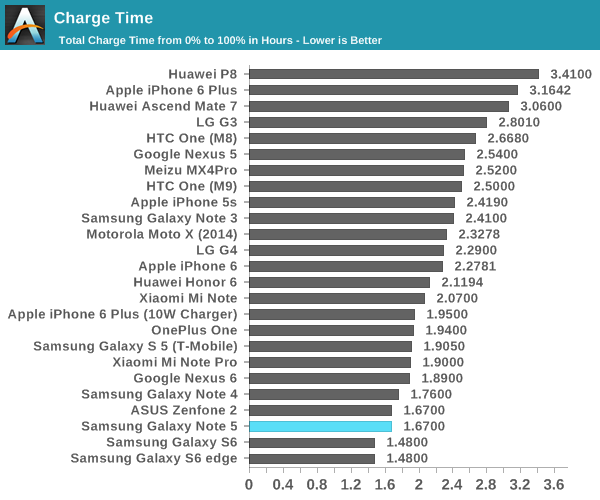
It probably isn’t a surprise, but charge time ends up similar to the Galaxy S6 and Galaxy Note 4. I suspect that we’ll be waiting until QC 3.0 to be able to see significant improvements as the current standard doesn’t have particularly fine-grained voltage scaling according to cable and phone conditions. Interestingly, the wireless fast charger is actually not too far off from the wired charger as it indicates 100% around 1.84 hours into charging which is almost identical to the wired fast charger.


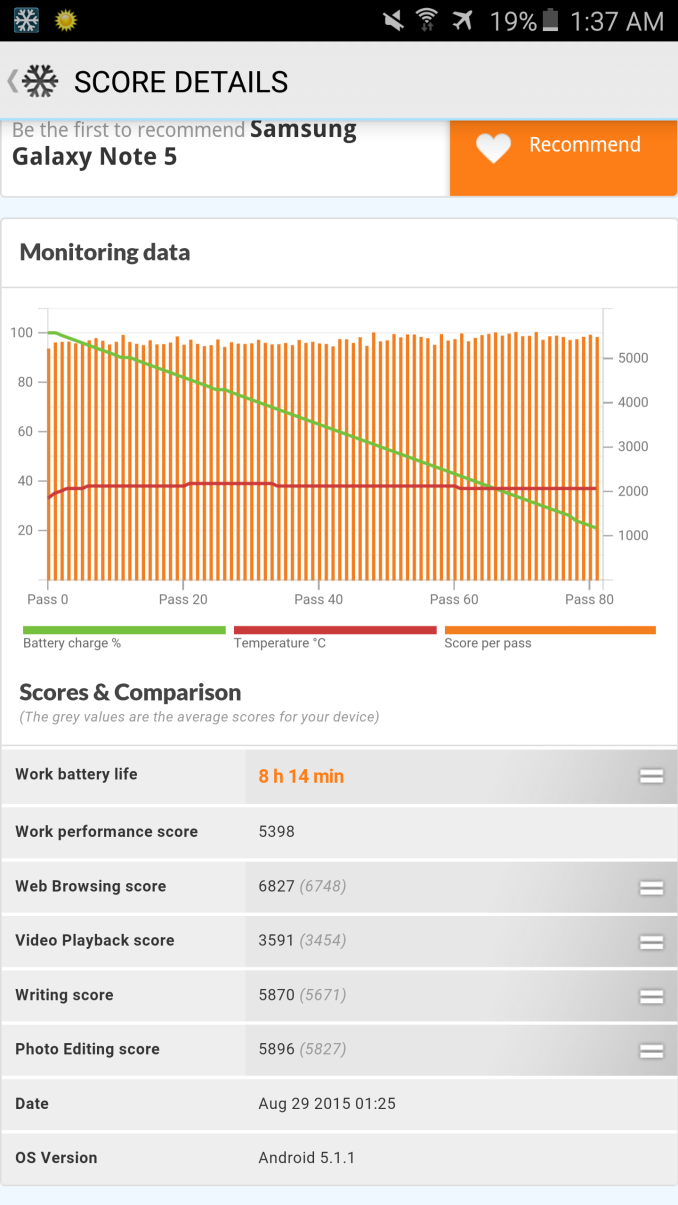
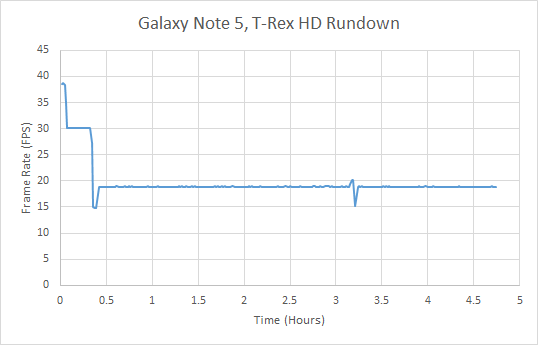
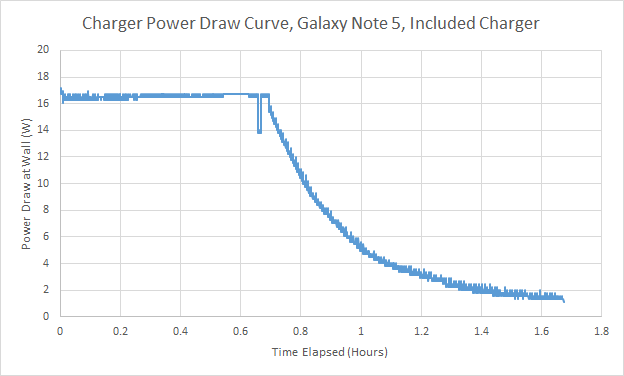
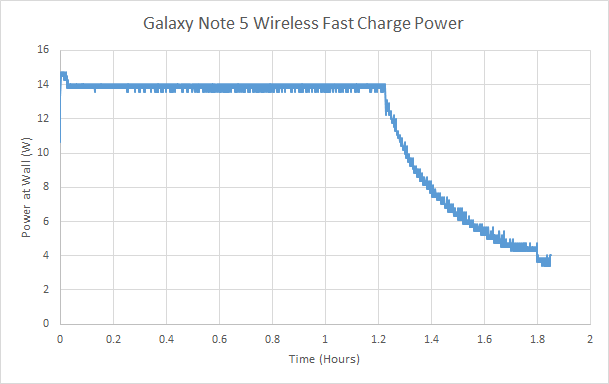








225 Comments
View All Comments
neoraiden - Friday, October 2, 2015 - link
Samsung lost me the second they announced they weren't releasing the note 5 in Europe. I hope they get enough of a dent in their sales from annoyed customers that they release the note 6 here after. I have a feeling that's wishful thinking though.Lavkesh - Friday, October 2, 2015 - link
Excellent review as always Joshua never mind the brand wars in the comments. I was always an iOS user and thought Galaxy Note 5 is a good enough device to jump the ship for the terms of a contract. While I am reasonably happy with the device, I still think Software is Samsung's biggest issue.I also noticed an issue with the S-Pen sensitivity where it does not work at all at the bottom left and right corners of the device. This means that if I need to take a screenshot which goes right until the bottom right or left corner I cannot do it because the sensitivity simply vanishes. Also attaching a video to exactly show what the issue is. Can you check if your device also exhibits the same behaviour.
https://www.youtube.com/watch?v=XN41nE1lWGI
Tech_guy - Friday, October 2, 2015 - link
Samsung relied too much on Exynos 7420 this year. The Note 5 is supposed to be a huge improvement and their better phone from the S6 which is already considered kinda old in the tech world. It's all the same tech just later in the year. Yawn. The iPhone 6s technology just obliterates this phone. Good luck Samsung, you're going to need itmercucu1111 - Friday, October 2, 2015 - link
Exynos 8890 is on ready dudeTech_guy - Monday, October 5, 2015 - link
Single core and most likely graphics performance won't match A9. I read a 45% increase in CPU performance that puts it under 2000 geekbench still.Arbie - Friday, October 2, 2015 - link
At first I was sad to see that neither of these included a microSD slot. That would be an awful omission on devices extremely well fitted to media consumption. That would rule them out of my consideration. But the photos made me wonder, so I looked further and found the slot mentioned in the middle of the review.Really... I know it is AT's sworn position that microSD is useless, irrelevant and obsolete... but how could you not even list it in the spec table? Just for those of us who continue to be deluded by our daily use of it. I never cease to wonder at the time and effort spent on describing case colors, and the blindness to important functional features.
Dobson123 - Saturday, October 3, 2015 - link
The S6, S6 edge, S6 edge+ und Note 5 DO NOT have a microSD slot.Arbie - Saturday, October 3, 2015 - link
Then these sentences are grammatically broken (wrong tense throughout): "The back cover is faux-leather plastic that peels off much like the Galaxy S2's back cover, with a removable battery and microSD slot. The display has the same buttons, but the bezel had a striped design for unknown reasons." As written this refers to the new devices, not the old ones!I won't even consider a device of this screen size without microSD. A read-only implementation would be fine (satisfying Android security needs).
Devo2007 - Sunday, October 4, 2015 - link
Those sentences shouldn't even be in this review. Definitely confusingDobson123 - Sunday, October 4, 2015 - link
They're about the Note 4.